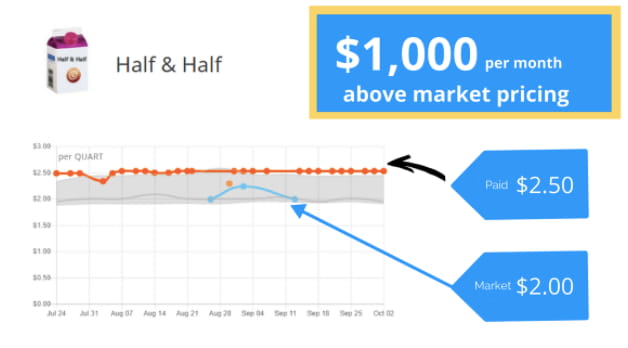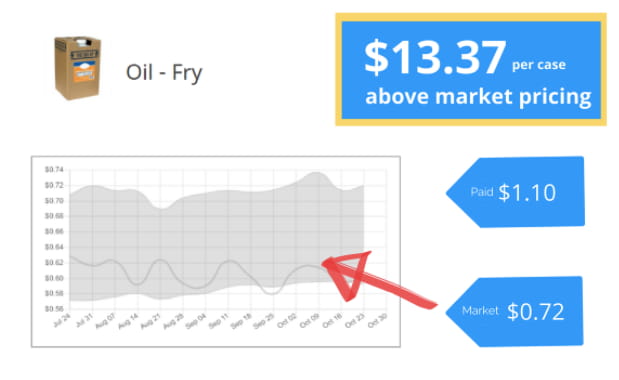They say if you stare at something long enough, eventually it will stare back.
That’s definitely how we feel about the supplier pricing data we’ve been looking at…
Last month we did a deep dive on supplier pricing data.
We analyzed 413,013 supplier purchases across the United States. The pricing data we evaluated came from 4,137 restaurants and 4,207 food distributors.
And as we looked at the data, well… it looked back.
It revealed some hidden truths about supplier pricing. And some of these truths were pretty darn shocking.
So, we’re here to share with you the 5 shocking truths you didn’t know about supplier pricing.
Ultimately, we think they serve to illustrate the fact that the restaurant business is hard and the supply chain doesn’t make it easier for the restaurateur.
Here we go…
Truth #1: 92% of Restaurants Overpay Their Suppliers
This was a big one… 92% of restaurants are overpaying their suppliers for items they purchase on a weekly basis.
We expected to find some restaurants were overpaying.
We were not prepared to find out that this really meant almost EVERYONE is overpaying.
And it was interesting to look at the patterns. It’s not just one or two items… most restaurants are paying above market price for multiple ingredients.
In fact, the data shows it’s closer to 5 – 15 items. Ouch.
And most of the stuff restaurants are overpaying on isn’t anything special… typically, it’s everyday items… things you don’t think twice about ordering.
But what it means is thousands of dollars in lost profits every month… money seeping out of the business because there’s no visibility into pricing and price changes.
A popular coffeehouse in Florida found this out the hard way.
The restaurant purchased anywhere from 72 – 96 quarts of half-and-half a week. And although management was paying the same price every week, it was $0.50 more per quart than what other restaurants in the local area paid for the same half-and-half.

That 50 cents per quart added up… the coffeehouse ended up overpaying almost $50 per week… and when they looked at it across a couple locations, it was closer to $1,000 per month.
Let’s just say they were getting roasted on their pricing.
And in this case, it was a secondary item of importance. Meaning not a top area of spend, but one that is still important.
Since then, they’ve worked with their supplier and negotiated a lower price on half-and-half. Now they’re saving $800 a month on this item… and over $9,600 a year.
Truth #2: Restaurants Regularly Overpay 86% More for the Same Ingredient
The second big revelation was how much restaurants were overpaying.
Sure, there was bound to be some price fluctuation in local markets… but 86%?
Yup, restaurants regularly pay 86% more for the same ingredient… from the same supplier… in the same market… in the same week.
Take for example a restaurant in Florida that recently discovered it was paying 86% more for a case of lettuce compared to another local restaurant.
It was the same supplier… in the same market… in the same week.
The first restaurant coughed up $53.75 for its case of lettuce… and the other lucky restaurant only had to hand over $28.91 for the EXACT SAME case of leafy greens.

$53 vs. $28… different restaurant… same everything else.
At a rate of a case of lettuce a week, that’s a $1,300 annual difference… for just one product.
And we’re not just talking about a difference in produce… we found price fluctuations include staples every restaurant buys.
Consider a casual dining restaurant in Connecticut…
They buy standard fry oil. You know the kind, the ones that come in 35 lb containers.
When we looked at their pricing, they were paying $1.10 per pound for the oil. The rest of the market was paying $0.72 per pound or less.
This was a difference of $13.37 per case for a commoditized ingredient.

Immediately, they negotiated the price down with their supplier. Within two weeks, the restaurant saved $161… just on fry oil!
Truth #3: Same Multi-Unit. Same Supplier. Same Market. Different Price.
One thing we definitely uncovered was how difficult maintaining standardized pricing is in a multi-unit.
If you’re a multi-unit restaurant concept with operations in the same area… you’re probably overpaying at one or more of your locations for the same ingredient.
From looking at the data, we can often see where the same restaurant concept… in the same market… with the same suppliers… gets a different price at each location.
Here’s what the purchase price of Red Potatoes looks like for a multi-unit concept in South Florida.
This restaurant has 6 concepts and 14 units.

As the chart shows, overall they are getting a good price on red potatoes.
BUT the price is not consistent from location to location.
AND the biggest kicker… the location with the highest price… well, it’s in the exact same mall location as the restaurant with the lowest price.
Multi-unit pricing is tough.
Truth #4: The Little Things Add Up
Perhaps the worst part about overpaying for supplies is it’s often on small, unnoticed and insignificant items.
Think stuff you order without thinking… which is why if prices go up on these items… you never notice.
But even the smallest price increases on these items can mean thousands in lost savings.
For example, do you order Ziploc bags? Of course, you do… probably hundreds a month without thinking. They’re a commodity product… so there’s no reason the price should ever change, right?
You would think so.
But the data is showing the opposite is happening more often than not.
For example, we found one restaurant paid $18.68 for a case of Ziploc bags… and that another restaurant paid $56.30 for the same case of plastic baggies.
That’s a 201% price increase.
Or consider the mystery of the sliced button mushroom… on a Monday, a restaurant paid $9.84 for a case of sliced button mushrooms.
Two days later on Thursday, the same restaurant paid $33.85 for the exact same amount of sliced button mushrooms… from the same supplier.
That’s a 244% increase in price… in just TWO DAYS!

Be careful…
It’s the gargantuan price increases on these overlooked items that can put the nail in the coffin for your food spend.
Truth #5: Price Creep Goes Undetected
The final shocking truth we saw was something we’re calling price creep.
It comes when you’ve paid the same price on an item for a really long time… and then the price jumps or spikes randomly for no real reason.
The price increase isn’t due to any market change. No difference in supply and demand. Rather, you made a new purchase and the price spiked. It usually happens when you haven’t made a purchase on a specific ingredient for an extended period then magically the price increases.
This is price creep… and it can severely damage your bottom line.
Here’s an example of a one time spike at a 3 unit burger chain. The price of bacon crept well above market prices for no reason.
With one order the chain overspent $180.75.

Conclusion: Pay Attention & Use Price Data for Better Prices
Maybe the most surprising truth we learned from looking at data and talking to restaurants was the stigma some restaurants held about negotiating prices…
- They didn’t know how to negotiate with suppliers
- They didn’t know negotiating was an option
- They didn’t know the extent to which they could negotiate prices
All in all? They felt the prices were the prices and that they had to accept them.
And that’s the strange thing about the restaurant business… there’s no standard pricing.
Sysco and US Foods don’t produce a standard pricing sheet for you and your city. They don’t even reveal pricing regionally or nationwide.
Instead, it’s a restaurant-by-restaurant price based on the rep and the business owner.
That means prices can ALWAYS be negotiated.
And you as the restaurant owner need to take steps to get the best price… on everything.
Why?
Because it’s a single-digit margin business…
Because food costs represent 30% of your operating budget…
And because managing this one area of the business means thousands more dollars in your pocket every month.
And you can take that to the bank… literally.
So the key takeaway from these 5 shocking supplier truths is that you need to watch your pricing and negotiate the best rates for your restaurant.
No other business eyeballs its expenses… especially when it represents 30% of the overall budget.
But this is a common practice in the restaurant business.
And this is a huge red flag.
But, it doesn’t have to be this way…
The Orderly app shows you local supplier pricing.
It provides a national & local view of price trends on over 100 of the most popular ingredients restaurants are buying.
Now you can see real prices other restaurants are paying their suppliers.
And now you’ll know if you’re overpaying for eggs, onions, ground beef and other items… and you’ll be able to negotiate better pricing with suppliers.
The Orderly app is the industry’s first guide to prices restaurants are paying for their supplies.
The best part? It’s free.
So, quit eyeballing your pricing…

